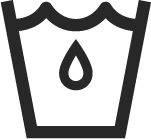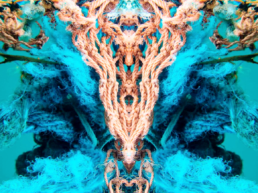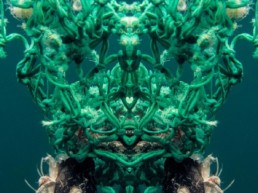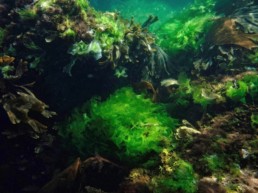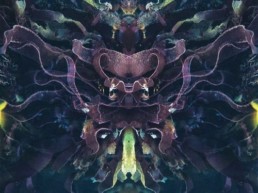January 2, 2018
Toxic Beauty: 10 Artists Using Polluted Waters to Address The Current Global Water Crisis
behind chaos and destruction there is beauty. a look at the creative ways the art community is raising public awareness of the global water crisis.
Janeanne has been deep-sea diving around the Scottish seas for the last ten years. Her expeditions have led her to discover a whole new beautiful world where gravity doesn’t apply as she captured a series of light images showing pollution in the sea. Her body of work revolves around the beauty and destruction surrounding us.
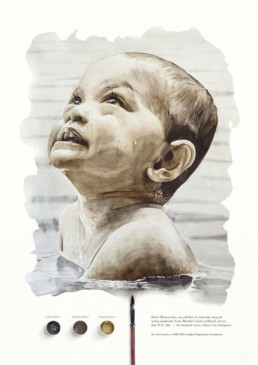
Participating artists used water from the polluted rivers in the Philippines to create a series of watercolors, after extracting and decontaminating the contaminated sludge from different streams of Manila, the pigments obtained were used to paint watercolors, bringing a disturbing dimension to these artworks. Juxtaposed with the paintings of innocent children playing in the water. TBWA\Santiago Mangada Puno agency created the Dirty Watercolor project for the ABS-CBN Lingkod Kapamilya Foundation, which seeks to clean up rivers and to raise awareness about the problem of water pollution.

Three students of the National Taiwan University of the Arts created 100 popsicles made from polluted waters of Taiwan’s lakes, rivers, beaches and ports to raise awareness on the problem of pollution. The contaminated water popsicles contain collected sewage samples that were first frozen and then preserved in polyester resin wrapped in packaging also designed by the team, the project highlights the contrast between what is beautiful and what is problematic for the environment.

John Sabraw is an artist and professor from Ohio who’s devised a unique way of raising awareness of his state’s pollution problem.
Using toxic runoff found in the Ohio River region, Sabraw produces his own DIY pigments — bold yellows and reds that are sourced from the oxidized sludge of abandoned coal mines. A masterful feat of art-meets-science on their own, the paint colors eventually became the basis for a primordially beautiful painting series, bringing light to the ecological dilemma of the river region.

For “Your waste of time,” Olafur Eliasson displayed pieces of ice that broke off from Iceland’s largest glacier, Vatnajökull. Exhibited in a refrigerated gallery space powered by solar panels, the ice “sculptures” represented 800 years of Earthly existence, putting human’s physical experience in perspective. “The obvious lesson of Mr. Eliasson’s installation, ‘Your waste of time,’ is that global warming is wreaking havoc on nature,” Ken Johnson wrote in The New York Times last year.
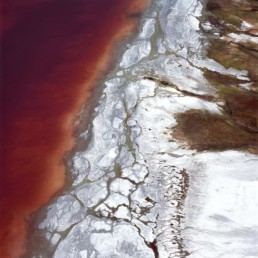
DAVID MAISEL – THE LAKE PROJECT
As engaged as he is in the surrounding issues, Maisel is not attempting to make accurate records of environmental destruction. Instead, he seeks a distance that scrambles a conventional reading of the landscape. In this altered state, the laws of gravity are undone, the solid ground gives way, and the photograph is experienced as a transcendent vision or tone poem, as much as a map of ecological disaster.” —Aperture, volume 172, Fall 2003

STEVEN HIRSCH – GOWANUS WATER
Peer into the Gowanus Canal in New York City, and you’ll see what is widely recognized as one of the most polluted bodies of water in the United States. The contamination is so severe that the canal has been designated a Superfund site.
Stunning with toxic beauty, the abstract and psychedelic work on view was captured by Steven Hirsch’s lens at the Gowanus Canal in Brooklyn, one of America’s most polluted waterways. Revealing otherworldly waterscapes in the slime and detritus atop the tainted water, Hirsch’s painterly images swirl in a frenzy of elusive shapes and bright and explosive colors.

Exploring issues impacting water quality and sustainability both within the Midwestern region and globally. WATER is essential to life, at times calming, at other times powerful and difficult to control; seemingly abundant, but increasingly scarce. Exploring and understanding WATER in a multitude of forms – as a conduit for transportation and civilization, as an environmental resource, and as one of nature’s most versatile tools – was the theme of KANEKO’s Spring 2016. WATER explores issues impacting water quality and sustainability both within the Midwestern region and globally. These concepts were highlighted through the combination of scientific data and fine art while encouraging visitors to consider their relationship with water – how water impacts our community, our health, and our perspectives.
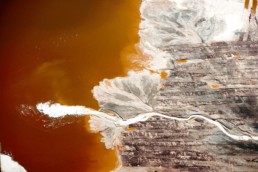
Photography of J Henry Fair simultaneously captures the beauty and horror of human pollution, from thick oil spills to dirty coal mining. Fair believes we all play a part in this wear and tear on our planet. It’s not just Big Oil or the coal industry; it’s everyone. Everything and everyone are connected. Yes, it’s a bit of a cliche, but that doesn’t make it any less real. One example is how bauxite pollution has a symbiotic relationship with toxic coal ash waste because the production of aluminum consumes five percent of all energy generated domestically.
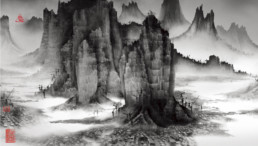
Commissioned by the China Environmental Protection Foundation, Yong Liang Yang utilizes the traditional art style in ads to promote awareness of major environmental problems. Viewing the painting from a distance, this appears to be a beautiful, dreamlike, and traditional Shan Shui painting. Upon closer examination, the markers of urbanization suddenly reveal themselves. Human-made objects have supplanted the natural world. Skyscrapers take the place of mountains. Construction cranes, a common sight in modern Chinese cities like Shanghai, populate the landscape in excess. The ethereal and purifying mists, a common element of Shan Shui paintings, is, in reality, a miasma of suffocating smog.
